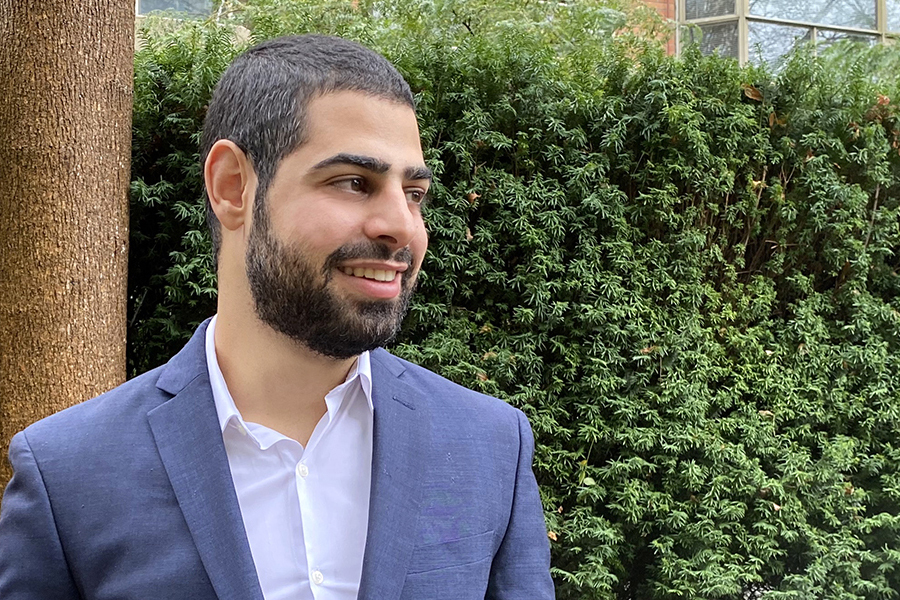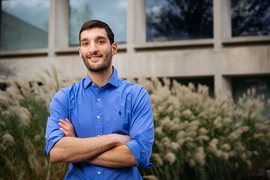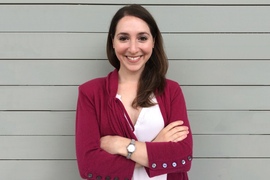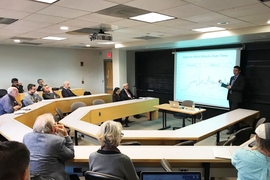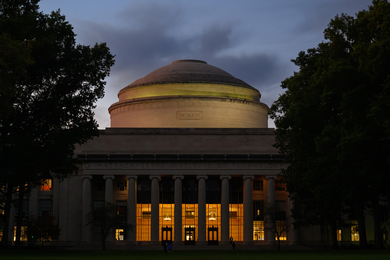Growing up in the suburbs of Chicago, Nasir Almasri heard so many discussions about the political struggles of Palestinians that by the time he was 7, he thought he’d heard enough to last a lifetime. He was wrong.
Decades later, Almasri is now in his fourth year in the MIT political science PhD program pursuing answers to thorny political questions around authoritarian regimes and opposition groups — scholarship with deep roots in the dinner-table conversations of his childhood.
In 2000, when Almasri was 7, intensified violence erupted between Israel and Palestine, a period known as the Second Intifada, or Al-Aqsa Intifada. The Intifada, a reaction to the failed peace process, resulted in five years of intense contention between Palestinians and Israelis.
It is also a moving example of the kind of strife that emerges at the intersection of politics and religious traditions, the very types of conflict that Almasri is studying at MIT. With a particular focus on West Asia and North Africa, he explores how opposition groups exist across time and the rise and fall of various social movements. Among his questions: What are the roles of opposition groups in social movements? And, why do opposition groups sometimes use escalatory strategies, like rough public rhetoric or even violence against regimes?
First steps in activism
Although the violence of the Second Intifada was a world away from Almasri’s suburban community and American childhood, the shock waves of that prolonged event helped shape him. It wasn’t until entered college at Southern Illinois University Edwardsville, however, that he was jarred into activism.
The campus, in a suburb of St. Louis, Missouri just inside the Illinois border, was an “interesting place,” Almasri recalls, “not just because it was predominantly white [as his high school had been], but also because the students were predominantly from rural areas. Some had never met a Muslim or an Arab before. They were like 'What does that mean, all I know is from TV' — so I had to explain myself a lot. That’s when I found myself reading more.”
The feeling of being set apart by his college classmates also led Almasri to consider the injustices that afflicted others in his immediate surrounding in St. Louis. Soon he discovered a group of experienced activists and organizers — mentors with whom he began to work on various campaigns around the city.
He began working with the local government in St. Louis to stop unsafe waste disposal practices, which occur in St. Louis minority neighborhoods, in Palestine, and many other far-flung places. Among his group of activist mentors were a Palestinian woman from the Quaker community, a white American woman who worked with St. Louis shelters, and an Auschwitz survivor.
“I learned from a lot of people why they care so much about fairness and justice,” reflects Almasri, “and how the conflicts affect them wherever they are.”
Academic exploration
And so, while Almasri continued along his academic path — earning his BA from Southern Illinois University Edwardsville and his MA in international relations from the University of Chicago before coming to MIT — he also worked to remedy a set of interconnected social inequities, including investments in private prisons, international human rights violations, and the unsafe waste disposal practices that afflict many minority neighborhoods.
One difficult lesson Almasri learned about activism from those early days was about timing, persistence, and taking the long view: “Activism is slow. It’s 95 percent failure, at least,” Almasri says now. “You’re trying to change systems of power, and you’re trying to convince other people who don’t have time to care. It’s not as helpless as that sounds; change does happen all the time, but it’s not going to happen the first day you step your foot in the door.”
Why is that?
Activism takes years of hard work and dedication, not unlike an advanced MIT degree. At MIT, Almasri’s research and coursework focuses on two areas that relate directly to his activist vision: social movements and authoritarian regimes. “I’m specifically interested in opposition groups,” he says. “Social movements rise and die, rise and die, over time, and opposition groups are more or less consistent over time.” In other words, a long-lived organization will ride the tides of social change and respond to shifting times. Almasri asks: Why is that?
One current subject of his study is the Muslim Brotherhood, one of the most well-known Islamist groups in the Middle East, with loosely linked chapters that respond to various regimes in their respective nations. “The Syrian Muslim Brotherhood had been very tip-toey around the Syrian regime, but when the Syrian regime solidified in the ’70s, all of a sudden the Syrian Brotherhood escalated,” Almasri observes.
“I’m studying principal-agent problems” — situations when one individual is allowed to make choices on behalf of another — “within a group. Why does a group lose control of some agents?” He is also interested in why and how violent factions emerge from generally nonviolent opposition groups, as they did in Syria in the 1970s and Egypt in the 1940s.
Close to home
At the same time, Almasri continues to be motivated by the political struggles of Palestinians that he first learned about as a small child. A major part of his activism today centers on opening discussion around the intertwined histories of Zionists (backers of the Jewish state in Israel) and Palestinians and how their trajectories create the fear and conflict that is entrenched in the region. He works to be direct about the factors that have shaped the crisis and the reality of what it looks like on the ground.
For his part, Almasri views the conflict as a human rights violation. In his opinion, “There is no level playing field between the two sides. Palestinians live under military occupation: they have to go through checkpoints with iron cages to get from city to city, or even to go to work. Their houses are demolished and replaced by Israeli-only settlements. Refugees, some of whom live within miles of their homes, are denied the right to return.
"Even Palestinians like myself — who carry American passports and are relatively privileged despite living in the diaspora — endure hours of interrogation in attempting to return to Palestine and are sometimes denied entry.”
The human experience
As part of an annual series of lectures, discussions, and rallies, Almasri helps to foster dialogue and education with MIT community members on both sides of the issue. “We have students who come into meetings and say, ‘Hey, I’m a Zionist and I’m here to see what your perspective is.’ That’s led to some really, really good conversations,” he says.
At the heart of this work, says Almasri, is the imperative to humanize the people involved directly in the conflict: to keep the perspective of human experience and suffering in the picture, rather than only the contentious political questions that drive those experiences.
“Humanizing is actually a really difficult process once you get buried in the middle of this incredibly fraught debate,” says Almasri.
Where an argument for one side or the other can lead to accusations of bigotry — whether anti-Arab or anti-Semitic — Almasri champions the view that that everyone deserves dignity and respect for their identity in the struggle for equal rights. At the same time, he notes that power differentials must be acknowledged when searching for real, viable political solutions; humanizing is only one element in a long and complex process.
